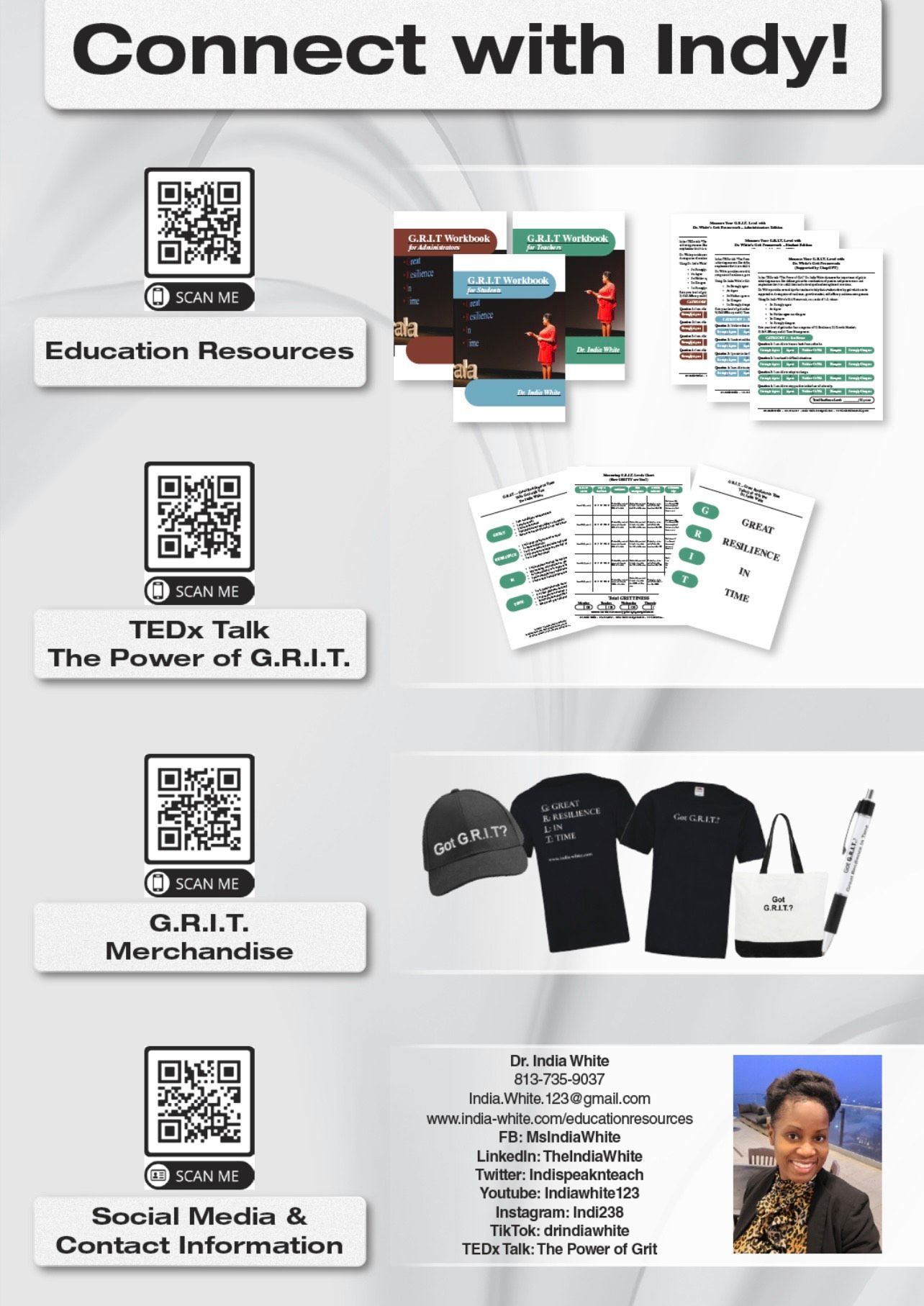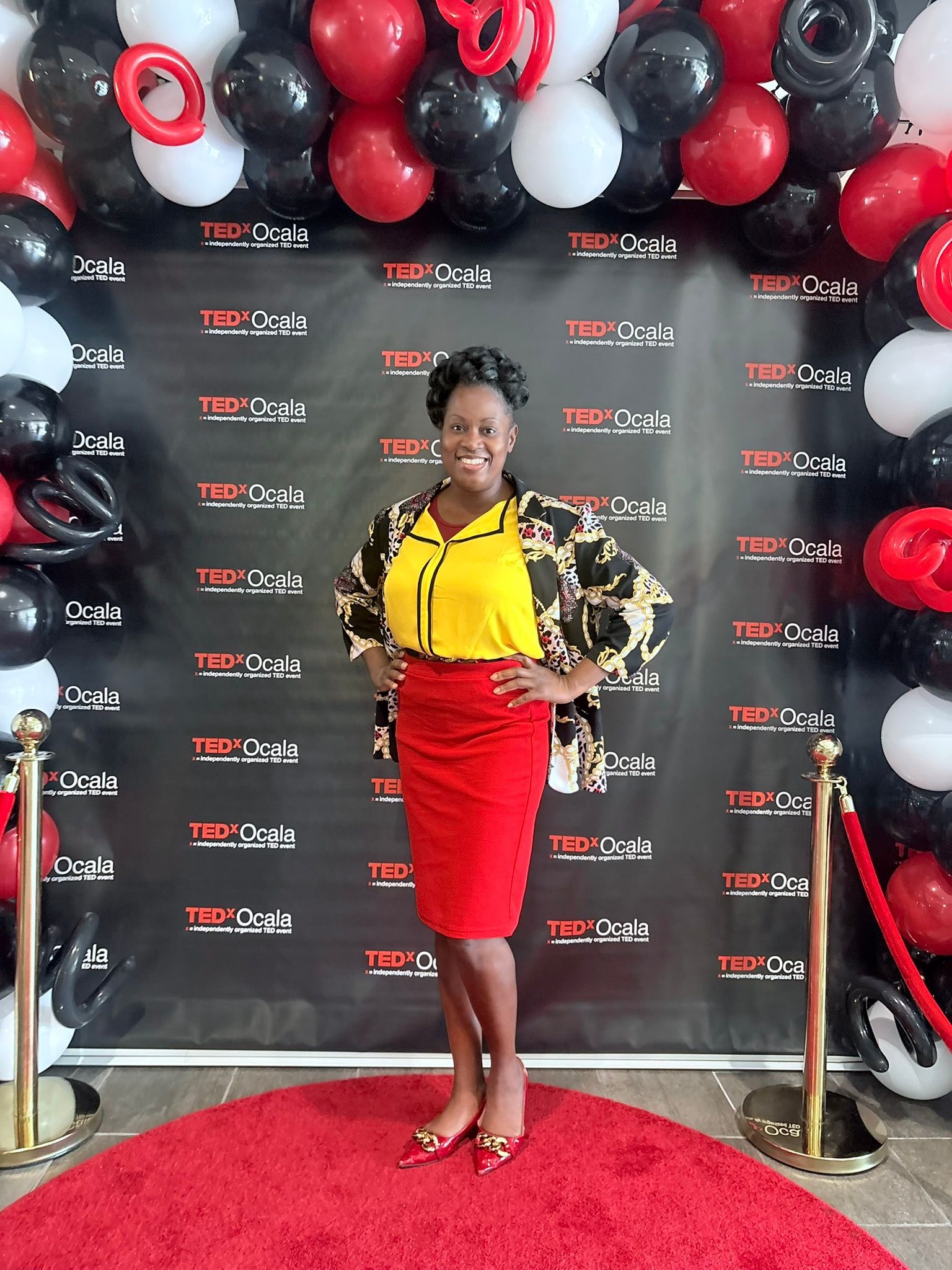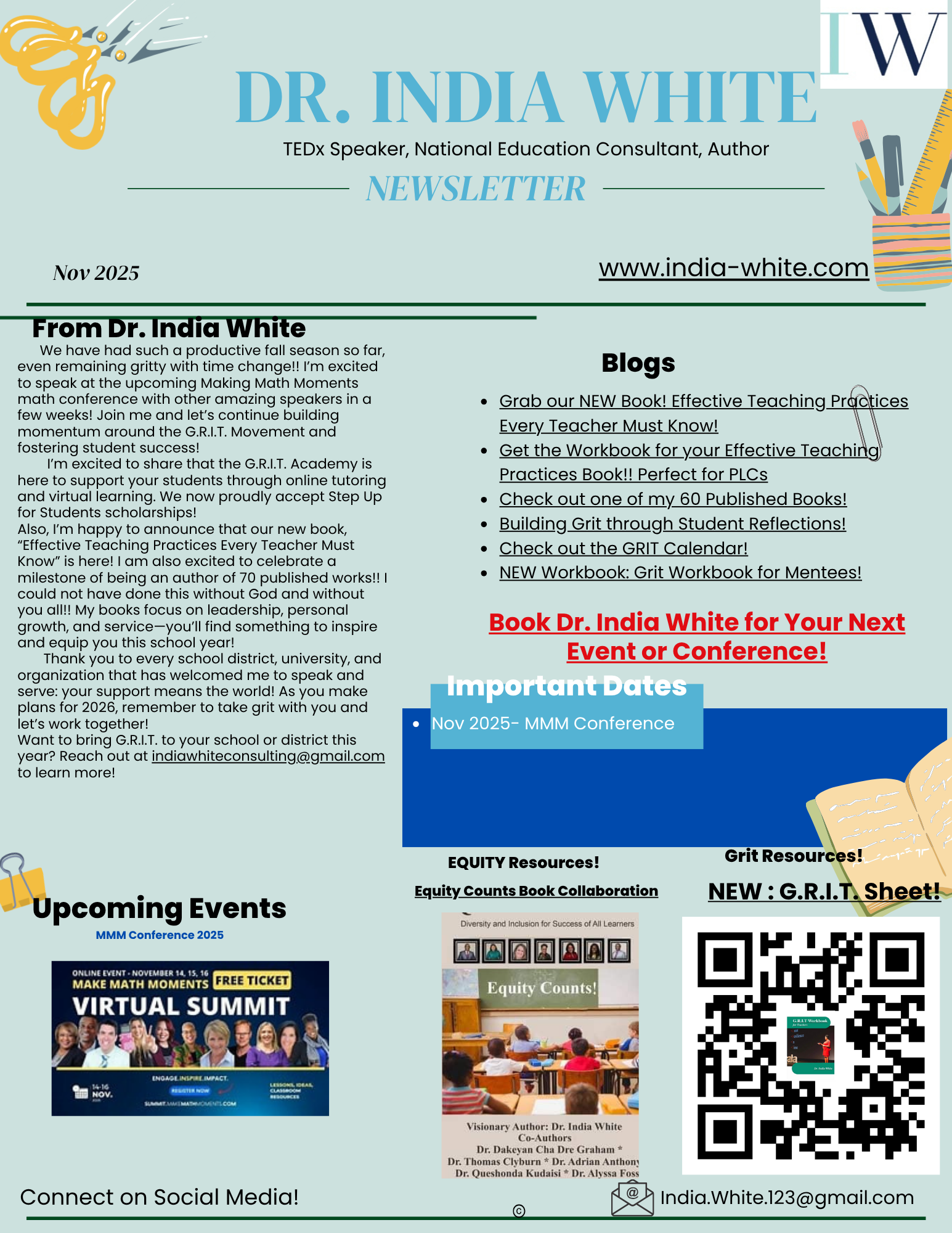Building GRIT in the Math Classroom
India White • June 21, 2023
Building GRIT in the Math Classroom

Building Grit In the Math Classroom
Grit is a key factor in success, both in math and in life. It is the ability to persevere through challenges and setbacks. As a math teacher, you can help your students develop grit each day. As you help students understand the concept of grit, having a gritty mindset, and how to cultivate grit, they will be able to overcome obstacles faced during instruction, math discourse and math anxiety. Here are some strategies for building grit in math class:
1. Cultivate a Growth Mindset in Students
A growth mindset is the belief that intelligence and abilities can be developed through hard work and dedication. Research has shown that teaching a growth mindset can help students develop grit, aka, “academic tenacity”. When students believe that they can improve their math skills through hard work, they are more likely to stick with it when the going gets tough.
One way to teach a growth mindset is to praise effort, not just achievement. For example, instead of saying "You're so smart," say "I can see how hard you worked on that problem." This helps students understand that effort is what leads to success. Further, allow students to take control of instructional delivery through sharing opinions during real problems. Allow students to lead moments of mathematical discourse, activities for math practice. Further, challenge them with various opportunities during class practice to strengthen student voice. This validates the findings of studies that have shown that students can grow from a fixed mindset to a growth mindset, which helps them to develop a math identity which results in mathematical achievement. A growth mindset is what will continue to help learners bounce back during moments of discouragement during learning and to remain confident that they’ve got what it takes to be successful in math.
2. Provide opportunities for practice
Mathematical practice is essential for developing grit. When your math students have the opportunity to practice their math skills, they are developing the grit they need to persevere through challenges. Provide your students with plenty of opportunities to practice their math skills, both in class and at home. Allow students to express their work through use of whiteboards, manipulatives, and other tools that can help them elaborate on their thinking during conceptual understanding. Further, refer to the standards for mathematical practices
as a roadmap to navigate through various parts that take place during their learning. For instance, as students are attending to precision, be intentional as you scaffold them through the problem. Ask questions to dig through their prior knowledge and keep them aligned to benchmarks discussed during the lesson. As you do this, continue to check for understanding and compliment students as they make strides during their persistence.
Another way teachers can provide opportunities for practicing math is to use online math programs. Research has shown that online math programs can be effective for improving math skills. For example, a study by Rakes et al. (2010) found that students who used an online math program showed significant improvement in math skills compared to a control group. As you make use of math programs, make sure the program is one that provides rigor, speaks to multiple learning styles, and can really build students from procedural fluency to conceptual understanding while providing feedback for growth.
3. Use Real-World Examples and Math Projects
Real-world examples can help your math students see the relevance of math in their lives. When students understand how math is used in the real world, they are more likely to develop the grit they need to persevere through challenges. Use real-world examples to help your students see the value of math and to motivate them to keep trying. As they build upon the relevance, this increases their engagement which impacts their grit levels in a positive way. Studies have shown that grit has had a significant and positive affect on student engagement and academic achievement. With the help of real world problems, students can have a sense of ownership and pride in their work as they prove that they are achieving in their math class.
One way to use real-world examples is to incorporate math into everyday activities. For example, you could have students calculate the cost of groceries or the distance between two cities. This helps students see how math is used in their daily lives. Further, allow students to work on real-world math
projects that require rubrics and assign roles to hold them accountable. This also exposes them to the reasons why they would need to learn particular math concepts in the classroom and how it is relevant for their lives.
4. Encourage Peer-to-Peer Collaboration
Healthy peer-to-peer collaboration can help students develop grit. When students work together, they can support each other through challenges and setbacks. Encourage collaboration in your math class by assigning group projects or having students work in pairs.
One way to encourage collaboration is to use cooperative learning strategies. For example, you could have students work in groups to solve a math problem. This helps students learn from each other and develop teamwork skills. Dr. Linda Kagan provides several collaborative strategies that help students remain organized while working together including round robin, turn and talk and more!
Choose to invest in some of these collaborative strategies as you build a learning environment of adventure and exploration for your students.
5. Provide Moments for Teacher feedback
Feedback is essential for learning and growth. When you provide feedback to your math students, you are helping them develop the grit they need to persevere through challenges. Provide your students with constructive feedback that helps them understand what they are doing well and what they need to improve. In their article on the Power of Feedback, Dr. John Hattie and Dr. Helen Temperley (2007) speak on how teacher feedback helps contribute to student gains and achievement when implemented effectively.
Students need to know that they are making progress, and they are looking to their teacher to give them affirmation and confirmation.
One way to provide feedback is to use formative assessments. Formative assessments are assessments that are used to provide feedback to students during the learning process. For example, you could have students take an exit quiz after each math lesson to see how well they understand the material. Further, having various forms of assessment, i.e., giving an oral assessment, having students create math quiz or test questions, and project-based learning opportunities can help you truly understand where students are in their understanding of their learning.
Conclusion
In conclusion, building grit in math class is essential for your students' success in your math class and in life. By teaching a growth mindset, providing opportunities for practice, using real-world examples, encouraging collaboration, and providing feedback, you can help your math students develop the grit they need to persevere through challenges. It’s never too late to build grit with students. As you implement these five strategies, and follow-up with students with fidelity, they will grow into independent thinkers that you can facilitate through a lesson towards great progress, leading to proficiency. Remind students to use great resilience in time
as they navigate through math with success!
References:
Rakes, G. C., Valentine, J. C., McGatha, M. B., & Ronau, R. N. (2010). Online mathematics homework increases student achievement. Contemporary Educational Psychology, 35(2), 123-130. doi: 10.1016/j.cedpsych.2010.01.005
Hattie, J., & Timperley, H. (2007). The Power of Feedback. Review of Educational Research, 77(1), 81–112. https://doi.org/10.3102/003465430298487


✨ Have you watched the conference yet? ✨ If not, now is the perfect time to click the replay and experience the 2nd Annual Getting Gritty for the New Year Conference! 💪✨ This powerful global gathering brought together dynamic keynote speakers from Australia, England, California, and across the world, all united by one mission—helping women and leaders step boldly into the new year with G.R.I.T. A heartfelt thank you to our incredible keynote speakers and everyone who showed up ready to grow, persevere, and lead with purpose. 🌍💫 👉 Click the replay, get inspired, and get gritty for the year ahead! #GettingGritty #DrIndiaWhite #TEDx #GRIT #WomenLeaders #LeadershipDevelopment #GrowthMindset #Resilience #NewYearMomentum

It’s official! 💥 The 2nd Annual Getting GRITTY for the New Year Conference is HERE—and we’re starting earlier and stronger than ever! 💪🔥 📅 December 19, 2025 ⏰ 2:00 PM – 8:30 PM EST 🎥 LIVE on YouTube & Facebook 🎤 Featuring ALL Keynote Speakers: ✨ Dr. India White – Keynote & Vision Board Leader ✨ Miriam Putnam – Keynote ✨ Frances Helena – Keynote ✨ Leticia Francis – Keynote ✨ Siah Fried – Keynote ✨ Annette Garsteck – Keynote ✨ Live Panel Discussion – Q&A + Real Talk This powerful virtual experience will help you: ✔️ Build resilience ✔️ Strengthen your mindset ✔️ Set bold, gritty goals ✔️ Enter the new year with clarity, confidence, and purpose 🎯 Plus, don’t miss the LIVE Gritty Vision Board Experience led by Dr. India White! 🔗 Register here: https://forms.gle/FZv7YtWrjxpmA2ip9 🔴 YouTube LIVE: https://www.youtube.com/watch?v=4n-0A2NmQLw 🔵 Facebook LIVE Event: https://www.facebook.com/events/640093435791160 🔥 Let’s finish strong and step into the new year GRITTY! #GettingGritty #GritForTheNewYear #Resilience #GrowthMindset #VisionBoard #LiveConference #NewYearReset #drindiawhite

5 Ways to Build Mental Grit During the Holidays A G.R.I.T. Framework Guide for Leaders, Teachers, Students, and Families The holiday season is often painted as joyful and light-filled, yet for many people it quietly brings increased stress, emotional strain, financial pressure, and exhaustion. Leaders carry the weight of responsibility, teachers push through end-of-semester demands, students juggle expectations and transitions, and families try to hold everything together while honoring traditions, relationships, and rest. Mental grit during the holidays is not about forcing positivity or powering through at all costs. It is about enduring wisely. It is about staying grounded, focused, and emotionally regulated even when life feels full. Using the G.R.I.T. framework—Growth Mindset, Resilience, Self-Efficacy, and Time Management—we can approach the holidays with strength that sustains rather than drains. Below are five practical ways to build mental grit during the holiday season, supported by research and applicable across leadership, education, and family life. 1. Reframe the Season With a Growth Mindset A growth mindset reminds us that we are not required to get everything “right” to be successful. During the holidays, pressure often comes from perfectionism—perfect gatherings, perfect grades, perfect memories, perfect outcomes. Research on growth mindset, most notably by Carol Dweck, shows that individuals who view challenges as opportunities for learning are more resilient, persistent, and adaptive when plans change or obstacles arise. Instead of asking, “Did I do this perfectly?” ask, “What am I learning about myself in this season?” For leaders, this may mean learning how to delegate more effectively. For teachers, it may mean learning how to simplify instruction and expectations. For students, it may mean learning how to manage stress and uncertainty. For families, it may mean learning how to choose connection over comparison. Growth mindset allows grace to coexist with effort. 2. Strengthen Resilience Through Healthy Boundaries Resilience is not endless endurance; it is the ability to recover and return to balance. Psychological research on stress and coping highlights that stress is shaped not only by external demands, but by how individuals appraise those demands and the coping tools they believe they have available. One of the most powerful resilience tools during the holidays is boundaries. Healthy boundaries sound like: • “I can attend, but I will leave early.” • “I won’t engage in conversations that compromise my peace.” • “I will protect one evening a week for rest.” Leaders and teachers, in particular, experience emotional labor during the holidays as they support others while navigating their own responsibilities. Resilience grows when recovery is intentional—through rest, reflection, prayer, movement, or moments of quiet. Choosing peace is not avoidance; it is strategy. 3. Build Self-Efficacy Through Small, Meaningful Wins Self-efficacy, introduced by psychologist Albert Bandura, refers to a person’s belief in their ability to successfully execute tasks and handle challenges. Research consistently shows that self-efficacy predicts persistence, motivation, and emotional regulation. During the holidays, demands can feel overwhelming, which lowers confidence. The fastest way to rebuild self-efficacy is through micro-wins—small, achievable tasks that provide evidence of capability. Examples include: • A student completing one focused study session • A teacher grading one assignment set instead of everything • A leader completing one strategic priority • A family organizing one space or planning one meal Each completed task sends a message to the brain: “I can do hard things.” Confidence grows not from motivation, but from evidence. 4. Use Time Management as a Mental Health Tool Time management is often discussed as a productivity skill, but research increasingly shows its relationship to reduced stress and improved well-being. When time feels chaotic, the mind feels unsafe. Structure creates calm. A simple holiday time-management strategy is the GRIT Priority Plan: • Must-Do: Top three priorities that truly matter • Nice-to-Do: Optional activities that bring joy • Not-Doing: Tasks or expectations you are intentionally releasing Leaders, teachers, students, and families benefit when calendars include buffer time, rest time, and transition time. A schedule is not a restriction—it is protection. Managing time is managing energy. 5. Practice Recovery With Self-Compassion Grit without compassion leads to burnout. Research on self-compassion and mindfulness consistently shows reductions in stress, anxiety, and emotional exhaustion when individuals treat themselves with kindness rather than criticism. Mental grit does not mean ignoring emotions. It means acknowledging them without being controlled by them. A simple daily reset: • Inhale slowly for four counts • Exhale for six counts • Relax the shoulders • Repeat a compassionate phrase: “I am doing the best I can with what I have.” This moment of regulation helps the nervous system reset and supports emotional endurance through demanding seasons. A Final Word on Holiday Grit True grit is not loud. It is steady. It is choosing progress over perfection. It is protecting peace without guilt. It is believing you are capable—even when tired. It is managing time so life doesn’t manage you. It is resting without shame. This holiday season, remember: You don’t have to carry everything to be strong. You don’t have to do everything to be worthy. You can be gritty and gentle at the same time. That is mental grit—and it lasts far beyond the holidays. ✨ Invitation to Go Deeper With G.R.I.T. in 2026 ✨ As we prepare to step into a new year, this is your invitation to move beyond motivation and into transformation. Grit is not just about pushing harder—it’s about learning how to endure with purpose, clarity, and confidence. Through the G.R.I.T. framework—Growth Mindset, Resilience, Self-Efficacy, and Time Management—individuals and organizations across the nation have strengthened persistence, rebuilt confidence, and created sustainable success. If you are ready to build real grit in your life, leadership, classroom, or organization, I invite you to take the next step. 📘 Purchase a G.R.I.T. Workbook My G.R.I.T. Workbooks are designed to help you: • Strengthen mental and emotional endurance • Develop a resilient, growth-focused mindset • Build confidence through intentional action • Manage time and energy with purpose Each workbook is practical, reflective, and applicable to students, educators, leaders, families, and faith communities. 👉 Explore and purchase your G.R.I.T. Workbook at: www.india-white.com 🎤 Book Dr. India White for Gritty Work in 2026 If your school, district, organization, church, or leadership team is ready to cultivate grit in a meaningful and measurable way, I would be honored to partner with you. Speaking, training, and consulting topics include: • Building Grit in Leaders and Teams • Cultivating Resilience in Schools and Classrooms • Bridging the Achievement Gap Through Grit • Mental Grit, Well-Being, and Burnout Prevention • G.R.I.T.-Aligned Vision, Strategy, and Culture 2026 bookings are now open for: ✔️ Keynotes ✔️ Workshops & Professional Development ✔️ Retreats & Leadership Summits ✔️ Virtual and In-Person Engagements 👉 Request booking information or schedule a consultation at: www.india-white.com 🌱 A Final Word The new year doesn’t require a new you—it requires a grittier commitment to the growth already within you. Let’s do the work together. With purpose and grit, Dr. India White Ready to build real grit in 2026? 📘 Grab a G.R.I.T. Workbook or 🎤 Book Dr. India White for gritty leadership, school, or organizational work. 👉 Visit www.india-white.com

Title: Staying Gritty While Staying Well — 10 Essential Tips for Teachers, Principals, and Leaders By Dr. India White Every educator and leader carries a story marked by perseverance, sacrifice, and determination. Whether you’re guiding a kindergarten classroom, leading a school, or shaping district-wide decisions, you are required to show up daily with strength and consistency. Today’s professionals face growing demands, shifting expectations, and intensified pressures. Yet, in the midst of these challenges, educators continue to push forward with grit. But thriving in this vocation requires more than effort. It requires a marriage of grit and self-care. The G.R.I.T. Framework—Growth Mindset, Resilience, Self-Efficacy, and Time Management—offers a roadmap for teaching and leading with excellence while preserving emotional and spiritual well-being. Below are ten essential tips, enriched by research and practical application, to help you maintain grit while safeguarding your health. 1. Embrace a Growth Mindset Dr. Carol Dweck’s foundational research shows that educators who adopt a growth mindset exhibit higher motivation, stronger performance, and greater resilience when navigating challenges (Dweck, 2006). A growth mindset encourages educators to view setbacks not as failures, but as learning opportunities. When teachers and leaders shift their thinking in this way, they develop adaptability and emotional strength. This perspective reduces anxiety by reframing obstacles as steps toward mastery rather than indicators of inadequacy. In turn, this empowers educators to remain hopeful and open to new solutions, even during seasons of uncertainty. 2. Practice Micro-Resilience Daily Reivich and Shatté (2002) define micro-resilience as the small, intentional behaviors that strengthen our ability to bounce back from adversity. These everyday actions might seem insignificant, but research shows that consistent micro-interventions reduce stress and increase psychological stamina over time. Educators can practice micro-resilience by taking short reflective breaks, resetting between transitions, or engaging in calming breathing exercises. These strategies interrupt the stress cycle and help prevent emotional overload. By incorporating micro-resilience into daily routines, leaders strengthen their long-term grit while maintaining emotional balance. 3. Build Self-Efficacy Through Small Wins Albert Bandura’s work on self-efficacy demonstrates that belief in one’s capability significantly influences motivation, performance, and resilience (Bandura, 1997). Teachers and principals who recognize and celebrate small victories reinforce their sense of competence. These wins, no matter how minor, build internal momentum and enhance confidence. When educators track or verbalize progress, they strengthen the neural pathways associated with persistence. As a result, they are more likely to approach future challenges with optimism and determination. 4. Set Healthy Boundaries Angela Duckworth’s research highlights that grit is not about working endlessly, but about sustaining long-term passion and perseverance (Duckworth, 2016). To sustain grit, educators must create boundaries that protect their emotional and physical capacity. Setting healthy boundaries involves defining what tasks deserve your time, communicating needs clearly, and resisting the pressure to overextend. Leaders who practice boundary-setting demonstrate clarity, emotional intelligence, and responsible stewardship of their energy. By doing so, they model healthy work practices for their teams and prevent burnout. 5. Protect Time With Strategic Scheduling Time management is not merely a productivity strategy—it is an essential aspect of well-being. Research shows that effective time management reduces stress, improves decision-making, and enhances overall job satisfaction (Macan et al., 1990). Educators benefit from establishing routines that allow for focused work while making space for mental and emotional rest. Techniques such as time blocking, delegation, and prioritizing high-impact tasks create structure and reduce decision fatigue. When teachers and leaders guard their schedules with intention, they create an environment where purposeful work can thrive. 6. Cultivate a Supportive Community A supportive professional community is one of the most powerful predictors of educator well-being. Studies show that educators who feel supported by colleagues experience lower burnout rates and higher job satisfaction (Skaalvik & Skaalvik, 2010). Community fosters meaningful collaboration, emotional encouragement, and shared problem-solving. When principals and teachers rely on supportive networks, they build collective resilience that strengthens their ability to manage adversity. Investing in community is not an optional supplement—it is a critical component of long-term grit. 7. Engage in Reflective Practice Donald Schön’s research on reflective practice emphasizes that leaders who reflect consistently make more thoughtful decisions and respond more effectively to complex challenges (Schön, 1983). Reflection provides a mental framework for processing emotions, evaluating decisions, and learning from experience. Through journaling, prayer, or conversation with trusted colleagues, educators gain clarity and renewed strength. Reflection also helps identify patterns that may require adjustment, reducing repeated stress. By creating space for intentional reflection, educators deepen their capacity for resilience and long-term success. 8. Reconnect With Your “Why” Purpose is a powerful motivator that fuels grit. Research shows that individuals who connect with their core purpose are more likely to persist through obstacles and recover more quickly from setbacks (Seligman, 2011). For educators, this purpose might be a passion for student growth, a commitment to equity, or a desire to lead transformative change. When teachers and leaders revisit the moments that inspired their calling, they reinforce their emotional and motivational foundation. Purpose-driven educators remain anchored even when external circumstances shift. 9. Prioritize Well-Being Practices Studies consistently show that educators who engage in intentional well-being practices experience lower levels of stress and greater professional longevity (Jennings & Greenberg, 2009). Self-care is not indulgent—it is an investment in your ability to lead effectively. Incorporating spiritual reflection, exercise, rest, and emotional wellness activities enhances performance and protects mental health. These practices restore the mind and spirit, helping educators respond to challenges with calmness and clarity. By prioritizing wellness, teachers and principals can sustain grit without sacrificing their well-being. 10. Give Yourself Grace Self-compassion is strongly linked to resilience, motivation, and mental well-being (Neff, 2003). Grace allows educators to release perfectionism and acknowledge their humanity. When leaders treat themselves with kindness rather than judgment, they create space for growth and recovery. Grace fuels perseverance by allowing room for mistakes and fresh starts. In giving yourself grace, you strengthen your ability to push through obstacles without internalizing unnecessary stress. A Final Word of Hope To every teacher, principal, and leader reading this: you are seen, valued, and deeply appreciated. The challenges you face do not diminish your worth or your impact. You are making a difference every day, even when the results are not immediately visible. Remember that grit and self-care are not opposites—they are partners. With the right strategies, support, and boundaries, you can continue to thrive and lead with courage. Better days are ahead, and you have everything you need to navigate this season with strength and purpose. If you would like support in building grit within your school, district, or organization, I would love to connect with you. Visit www.india-white.com to explore speaking opportunities, coaching, workshops, books, Grit Trainings, and more. References Bandura, A. (1997). Self-efficacy: The exercise of control. Duckworth, A. (2016). Grit: The power of passion and perseverance. Dweck, C. (2006). Mindset: The new psychology of success. Jennings, P., & Greenberg, M. (2009). Prosocial classroom: Teacher social and emotional competence in relation to student and classroom outcomes. Macan, T. H., Shahani, C., Dipboye, R. L., & Phillips, A. P. (1990). College students' time management: Correlations with academic performance and stress. Neff, K. (2003). Self-compassion: An alternative conceptualization of a healthy attitude toward oneself. Reivich, K., & Shatté, A. (2002). The resilience factor. Schön, D. A. (1983). The reflective practitioner. Seligman, M. (2011). Flourish. Skaalvik, E., & Skaalvik, S. (2010). Teacher burnout and job satisfaction.

Thriving Through G.R.I.T. During the Holidays As the holiday season approaches, teachers can thrive by intentionally leaning into G.R.I.T.—Growth Mindset, Resilience, Self-Efficacy, and Time Management. This season often brings excitement but also fatigue, shifting schedules, and emotional demands. Embracing a Growth Mindset reminds teachers that progress—not perfection—is the goal, while Resilience helps them bounce back from daily challenges with grace. Strengthening Self-Efficacy empowers educators to trust their abilities and celebrate the meaningful wins happening in their classrooms each day. By practicing purposeful Time Management, teachers can protect their energy, set healthy boundaries, and create space for rest and joy. Thriving through G.R.I.T. allows educators to remain grounded, present, and empowered—ensuring they finish the semester strong while caring for themselves in the process. The holiday season brings joy—but also stress, expectations, emotional triggers, and exhaustion. Thriving through the holidays requires intentional grit: choosing growth, calm, and perseverance when everything around you feels rushed or overwhelming. Here’s how to lean into the G.R.I.T. Framework and maintain peace, productivity, and purpose. 1. Growth Mindset: Embrace Imperfect Progress * Allow room for changes in plans—weather, finances, or family dynamics may shift. * Don’t expect perfection; expect adaptation. * Remember that every challenge helps you grow in patience, flexibility, and self-awareness. * Reframe struggles as learning moments: “What is this teaching me?” Holiday Growth Mindset Affirmation: I release perfection and embrace progress, presence, and purpose.” 2. Resilience: Bounce Back With Grace When conflicts arise, pause before reacting. Practice your “resilience reset” (deep breaths, step away, pray, journal). * Protect your emotional boundaries—say no without guilt. * If grief or loneliness feels heavy, honor it. Resilience doesn’t deny pain; it rises through it. * Identify a daily habit that grounds you: morning prayer, gratitude walk, or music therapy. Holiday Resilience Affirmation : “I can rise again. I will not let one moment define my entire season.” 3. Self-Efficacy: Believe in Your Strength and Capability * Celebrate the small wins: the decorations that did get up, the gift you gave, the act of kindness you showed. * Avoid comparing your holiday to others—your journey is unique. * Speak encouraging truths to yourself: * “I am capable.” * “I’ve succeeded before; I can do it again.” * “I deserve rest and joy.” * Make choices that align with your values, not pressure or expectations. Holiday Self-Efficacy Affirmation: “I trust myself. I have what it takes to navigate this season with grace.” 4. Time Management: Protect Your Peace by Planning with Purpose * Create a holiday priority list—focus on what actually matters. * Schedule downtime, not just events. Rest is a strategy, not a luxury. * Set spending boundaries to avoid financial stress. * Use timers for holiday tasks (e.g., cooking, cleaning, shopping) to stay grounded and avoid overwhelm. * Delegate: You don’t have to do everything alone. Holiday Time Management Affirmation: “My time is valuable, and I protect it with wisdom.” Additional G.R.I.T. Tips for the Holiday Season • Practice Gratitude Daily A grateful heart fuels resilience and reduces anxiety. • Stay Connected to Supportive People Reach out to mentors, friends, or faith communities. • Nourish Your Health Sleep, hydrate, enjoy treats in moderation, and give your body movement. • Build a G.R.I.T. Tradition Examples: A family gratitude jar, “kindness day,” or reflection circle. • Pray, Journal, or Meditate Spiritual grounding builds inner calm and clarity. • Give Yourself Permission to Rest You can’t pour from an empty cup—refilling is an act of strength. Closing Encouragement G.R.I.T. isn’t just a framework—it’s a lifestyle. During the holidays, it helps you stay grounded, centered, and purposeful. Whether you’re navigating joy, grief, busy schedules, or family dynamics, remember: You are capable. You are resilient. You can thrive—not just survive—the holiday season. Thriving through G.R.I.T. choose to remain grounded, present, and empowered—ensuring they finish the semester strong while caring for themselves in the process. To learn more about G.R.I.T., explore future opportunities to collaborate, or check out my books and resources for educators, I invite you to visit my website at www.indiawhite.com. .

Making Grit Work at the Making Math Moments Summit: A Recap of a Powerful, Grit-Filled Experience Today, I had the incredible privilege of speaking at the Making Math Moments Summit, and it was truly amazing. From the moment we began, the energy was high, the curiosity was alive, and the commitment to transforming mathematics instruction through grit was stronger than ever. Even when we faced unexpected tech challenges, we modeled exactly what we teach: push through with perseverance, adapt with resilience, and keep moving forward. And yes, we did it with purpose and grit. Our theme for this session was Making Grit Work, and as we dove into the heart of the conversation, it quickly became clear that educators everywhere are hungry for tools that build students’ internal strength, not just their academic skills. Together, we explored what grit looks like in real classrooms, how we can cultivate it intentionally, and why it matters more than ever in today’s educational climate. One of the highlights of our time together was examining NAEP data and discussing how grit intersects with student performance nationwide. We didn’t shy away from the tough questions. We talked about the gaps, the realities, and most importantly, the opportunities. Grit is more than a concept; it is a framework for empowerment, a path toward confidence, and a catalyst for closing achievement gaps. It is the heartbeat of productive struggle. And today, everyone in that virtual room felt it. We also took the Grit Assessment, and that activity added an exciting layer of personal reflection. Educators saw where they personally shine in the pillars of my G.R.I.T. framework: Growth Mindset, Resilience, Self-Efficacy, and Time Management, as well as where they may want to grow further. The chat was full of insights, laughter, and “aha” moments as teachers rated themselves honestly and bravely. It reinforced why this work matters: before we can build grit in our students, we must first understand our own. What I loved most about this session was witnessing educators from all over the world lean in, reflect deeply, and commit to creating classrooms where students don’t just survive math, they rise in it. With every activity, discussion, and shared experience, the Grit Tribe grew bigger and stronger. I left the session inspired, grateful, and fired up for what’s ahead. Thank you to every educator who showed up, engaged, asked questions, and embraced grit with an open mind and open heart. Your dedication to your students and to your own professional growth is what keeps this movement alive. Let’s keep pushing forward, keep believing in ourselves and our students, and keep making grit work in every math moment. Stay gritty, Dr. India White

Attending TEDxOcala 2025: A Full-Circle Moment of Gratitude and Grit Attending TEDxOcala 2025 was nothing short of inspiring. Surrounded by brilliant minds and creative thinkers from across the globe, I was reminded once again of the transformative power of ideas. The event was filled with energy, innovation, and a deep sense of purpose as speakers shared their journeys and insights that challenged, uplifted, and encouraged everyone present to think bigger and live with intention. For me, the experience was also deeply personal. Returning to the stage where I delivered my TEDx talk in 2022 on The Power of G.R.I.T. brought a wave of gratitude and nostalgia. Standing there again, I couldn’t help but reflect on how much growth has happened since that pivotal moment. That talk wasn’t just a speech—it was a testimony to perseverance, resilience, and faith. It was a declaration that through Growth Mindset, Resilience, Self-Efficacy, and Time Management, we can overcome life’s toughest battles and rise into our purpose. Being back at TEDxOcala allowed me to reconnect with fellow visionaries, mentors, and new friends who continue to push the boundaries of what’s possible. It reminded me that we are truly better together. Collaboration and shared wisdom are what make communities thrive. Every person in that room carried a spark that contributed to something greater—an exchange of ideas that can ignite global change. Tips for Getting the Most Out of a TEDx Experience If you’ve ever wanted to attend a TEDx event or are planning to in the future, here are a few ways to make the most of it: 1. Be Present and Open-Minded. Listen with curiosity. Each speaker has a story, and sometimes the message that impacts you the most will come from an unexpected place. 2. Network with Purpose. TEDx events attract incredible people from all walks of life. Take time to connect, share your ideas, and build relationships that can lead to meaningful collaborations. 3. Reflect and Take Notes. Inspiration fades quickly if not captured. Write down key takeaways or quotes that resonate with you. Use them as fuel to inspire your work and personal growth long after the event. 4. Support the Speakers. Engage with them online, share their talks, and spread their messages. A simple act of encouragement can help amplify voices and causes that matter. 5. Apply What You Learn. The power of TEDx lies not just in listening but in doing. Let the ideas you hear challenge you to take action in your community, career, or personal life. How to Be Gritty in Your Career Attending TEDxOcala reminded me once again that grit is the bridge between inspiration and execution. Whether you’re an educator, entrepreneur, leader, or artist, your success depends not just on talent, but on your ability to persist through challenges. * Adopt a Growth Mindset: Believe that your skills and intelligence can be developed through effort and learning. * Build Resilience: View setbacks as opportunities to grow stronger, not reasons to give up. * Strengthen Self-Efficacy: Believe in your own ability to achieve goals—confidence fuels consistency. * Master Time Management: Prioritize purpose-driven actions each day to move closer to your vision. TEDxOcala 2025 was a beautiful reminder that the world changes when people dare to share their stories and embrace the grit it takes to make them real. As I left the event, my heart was full—thankful for the memories of 2022, the inspiration of 2025, and the reminder that we are all part of something much bigger than ourselves. We are better together. To learn more about my work on G.R.I.T. and how you can cultivate growth, resilience, self-efficacy, and time management in your journey, visit www.drindiawhite.com

Join me the week of November 14th as I speak for the Making Math Moments Virtual Conference!! 😃 I am excited to continue offering knowledge and sessions on grit and am open to traveling and working with schools, districts, and organizations as needed. Grit changes lives, and it’s my mission to make sure students and educators alike have the tools to thrive. As we step into this new season, I encourage you to reflect on where grit is showing up in your own life and in your work, and how you can be gritty in the upcoming NEW year. Together, let’s keep cultivating the power of G.R.I.T. in every classroom, community, and home. 😊 I'm here to support you and to work alongside you as we thrive and cultivate grit together. Visit my website www.india-white.com for more information and to see how we can work together 😊 . Link to Newsletter: https://lnkd.in/dpVxmaFp Get Your Spot at the MMM Conference: https://lnkd.in/dbCDkxvj hashtag#drindiawhite hashtag#grit hashtag#tedx hashtag#uf hashtag#savvas hashtag#teachers hashtag#students hashtag#principals hashtag#achievementgap hashtag#makingmathmoments Savvas Learning Company TEDxUniversity of Florida

Woohoo! I'm Super Excited to Launch my Nov. 2025 Newsletter!! 😁 This past month, I had the joy of launching the Grit Workbook for Mentees and doing a book launch with some amazing teachers on our NEW Book and Workbook titled, "Effective Teaching Practices Every Teacher Must Know" 👏 . As a result, I crossed a new milestone of being an author of 70+ published works! 🥰 (excluding math textbooks) and it was nothing short of powerful. Throughout the week, teachers engaged in activities designed to help them understand and apply the G.R.I.T. framework—Growth Mindset, Resilience, Self-Efficacy, and Time Management. 😎 I want to thank each and every one of you for being there with me on this journey as we spread the message of building grit across the nation. 🥰 I can think of several teachers, leaders, and organizations who held my hand through the process and for that I remain forever grateful. By the end of the week, it was clear that these new works have equipped teachers and students for success in life. 😊 Join me the week of November 14th as I speak for the Making Math Moments Virtual Conference!! 😃 I am excited to continue offering knowledge and sessions on grit and am open to traveling and working with schools, districts, and organizations as needed. Grit changes lives, and it’s my mission to make sure students and educators alike have the tools to thrive. As we step into this new season, I encourage you to reflect on where grit is showing up in your own life and in your work, and how you can be gritty in the upcoming NEW year. Together, let’s keep cultivating the power of G.R.I.T. in every classroom, community, and home. 😊 I'm here to support you and to work alongside you as we thrive and cultivate grit together. Visit my website www.india-white.com for more information and to see how we can work together 😊 . Link to Newsletter: https://lnkd.in/dpVxmaFp Get Your Spot at the MMM Conference: https://lnkd.in/dbCDkxvj hashtag#drindiawhite hashtag#grit hashtag#tedx hashtag#uf hashtag#savvas hashtag#teachers hashtag#students hashtag#principals hashtag#achievementgap hashtag#makingmathmoments Savvas Learning Company TEDxUniversity of Florida

New Book Launch: The G.R.I.T. Prayer Guide for Apostolic Believers — Now Available on Amazon I’m thrilled to announce the release of my newest devotional, The G.R.I.T. Prayer Guide for Apostolic Believers, now available on Amazon. Order your copy here: https://www.amazon.com/dp/B0FXS7FZSY?ref_=pe_93986420_774957520 This 365-day devotional and prayer journal was written for Apostolic believers who are striving to live a holy, Spirit-led life while growing in perseverance, prayer, and power. Built upon the biblical foundation of Acts 2:38-39; Acts 2:42, this guide invites you to strengthen your walk with God by developing daily habits of prayer, reflection, and spiritual growth. The G.R.I.T. Prayer Guide for Apostolic Believers is more than a journal—it’s a spiritual journey designed to help you build G.R.I.T., which stands for: * Growth Mindset – Renew your mind daily through the Word, embracing God’s promises with faith and expectation. * Resilience – Stand strong in the Apostolic faith, enduring trials with steadfastness and joy in the Holy Ghost. * Self-Efficacy – Believe that through the Spirit, you can live victoriously, walking in righteousness and truth. * Time Management – Dedicate daily time to prayer, fasting, worship, and studying the Scriptures to stay spiritually disciplined. This prayer guide empowers Pentecostal and Apostolic believers to pursue holiness and purpose. Each day includes space for prayer, reflection, and gratitude— helping you cultivate a lifestyle of devotion that keeps your heart fixed on God. Whether you are new to the faith or a seasoned believer, this devotional is a valuable resource to help you stay anchored in God’s Word, develop endurance, and walk boldly in Apostolic identity. As you journey through the year, you will find yourself strengthened by Scripture, renewed in purpose, and ignited with spiritual fire. Just as I shared in my TEDx Talk, “The Power of G.R.I.T.,” this guide reminds us that G.R.I.T. means Great Resilience In Time. Through prayer and daily devotion, Apostolic believers can develop the spiritual resilience needed to withstand the storms of life while staying faithful to the Lord’s calling. Use this devotional as part of your morning or evening prayer routine, during fasting seasons, or in group study with fellow believers. Let it become a tool that draws you deeper into the presence of God and helps you grow in both discipline and anointing. Order Your Copy Today The G.R.I.T. Prayer Guide for Apostolic Believers is now available on Amazon at: https://www.amazon.com/dp/B0FXS7FZSY?ref_=pe_93986420_774957520 May this guide strengthen your walk with God, deepen your prayer life, and help you live with Great Resilience In Time—for His glory. For ministry connections, speaking engagements, or more G.R.I.T. resources, visit me at www.india-white.com. Grab Your Copy from Amazon Today!